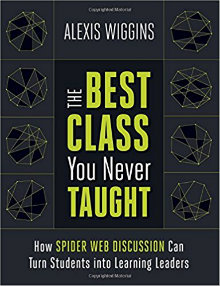Spider Web Discussions Put Students in Charge
The Best Class You Never Taught: How Spider Web Discussion Can Turn Students Into Learning Leaders
By Alexis Wiggins
(ASCD, 2017 – Learn more)

Professions of today require new skills, the most important of which is communication. This ability to listen, ask good questions, discuss problems and collaborate are paramount to what the modern job market is looking for in their new employees.
The book that is going to help teachers lead students to stand out from the crowd is The Best Class You Never Taught by Alexis Wiggins. The method that she uses is the Spider Web Discussion strategy.

Harkness’s idea was to move beyond rote lecture and have the teacher and students sit around a table and discuss a topic. Everyone would question, contribute and collaborate. Wiggins has taken this method and enriched it to provide more detail about process, assessment and self-reflection.
The name Spider stands for
Synergetic
Practiced
Independent
Developed
Exploration
Rubric
Web comes from the web-like graph that is drawn to keep track of the discussion.
The author (daughter of Understanding by Design creator Grant Wiggins) thoroughly explains her strategy to help us get started. The chapter on The First Spider Web Discussion relates all of the steps involved, such as making a rubric, choosing a topic or text, and debriefing after the discussion.
Specifics across content areas
In subsequent chapters, Wiggins adds information about giving feedback and its importance, as well as more specific examples of the use of the spider web in various classrooms. Examples are given for Science, Language Arts, Social Studies and a Statistics course.
Roadblocks to success are also addressed, particularly shy and talkative students but also the perpetual dissenter. In these situations she suggests having everyone write before they have to talk to give think time. Giving feedback and assigning discussion roles can also help with classes that have students that either refuse to participate or are more confrontational in their manner. Wiggins also includes strategies to manage Spider Web-style discussions with larger class sizes.
Beyond the Web: real time coding
Finally the author gives two chapters of advice on using this discussion method. One pertains to using it for assessment which suggests that along with the line graphing of who’s talking that you also devise a code for data such as off topic, or advances the conversation, or interrupts. Placing the codes by the students exhibiting those behaviors will give you valuable information for planning and individual student conferencing.
The benefits that are gained from this strategy are the subject of the other chapter. These can be as diverse as encouraging empathy, better homework completion, and more autonomy and excitement for you class.
Targeted research
Each chapter also includes sidebars on Research, Advanced Applications, Voices from the Field, and the Big Takeaway. The research is related to specific topics that she deals with in that section. For example in one small study in 2012, it was found that using culturally relevant texts showed an increase in engagement with African American boys.
The Advanced Applications feature gives more insight and ideas to assist us. Voices from the Field demonstrate the method by describing the work of actual teachers and their experiences. Finally the Big Takeaway summarizes the chapter highlights.
Overall, the Spider Web Discussion sounds like a great technique that I would like to try, especially because of the resulting benefits to the students.
Joanne Bell is a middle school teacher at St. Joseph Elementary School in Cottleville, Missouri. She currently teaches social studies to sixth and seventh graders, but has spent most of her 34 years in the elementary grades.





























